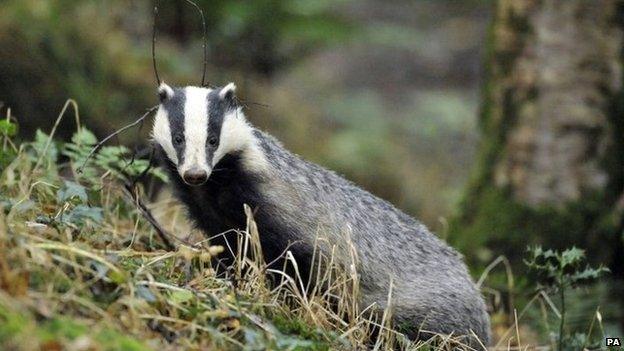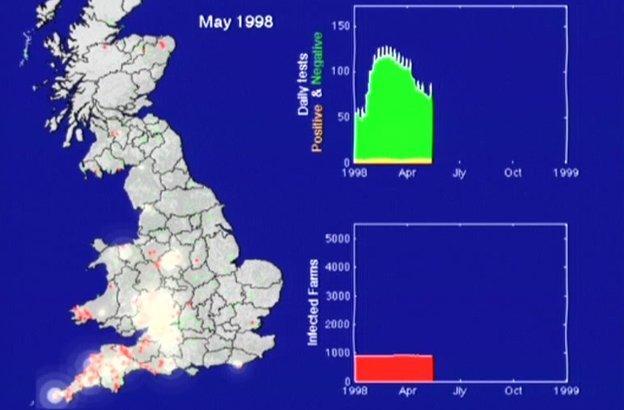Badger cull 'won't control bovine TB'
- Published
- comments

The paper, written by the universities of Warwick and Cambridge, suggests a badger cull has only a small impact on the spread of bovine TB
Bovine TB is a slow moving, unpleasant disease that is having a huge impact on the health of our cattle and on our wildlife.
But we know surprisingly little about how it spreads and what is the most effective way to control it.
That's one reason for the controversy over the badger cull.
I could find you thoughtful, respected scientists who have studied data on the cull and have arrived at polar opposite conclusions about its usefulness in controlling the spread of bovine TB.
So a new computer model from the universities of Warwick and Cambridge gives all sides in this debate much to think about.
Since 2008, Dr Ellen Brooks-Pollock has been building a simulation of the spread of bovine TB in the UK. The UK is in a strong position to do this, because we have an exhaustive collection of data on cattle movements.
Farmers may grumble about the paperwork involved in cattle passports but it has created a data set that's the envy of the world.
Role of badgers
While the cattle movement data is the backbone of this simulation the researchers have also built in other variables that have an impact on the spread of the disease, including transmission between cattle and the effectiveness of the TB test itself.
They have also modelled the role badgers play in spreading bovine TB, at least as well as they can.
We don't have the same sort of detailed data on badgers that we do for cattle. So it's not possible to directly simulate badger behaviour and the impact it has. But you can introduce a general "local environment parameter" to the model.
That includes the effect of badgers, other mammals and even the role of infected pasture.

The simulation shows the potential spread of bovine TB after an outbreak
Ways to control bovine TB
And the model works. It accurately reproduces the geographical spread of the disease and the number of cases over time.
But what's really interesting is you can then take the various parameters and see what impact different approaches to the disease will have. According to the model the three most effective things we could do to control the spread of bovine TB are:
Cull entire herds when infected cattle are found.
Use a cattle vaccine.
A one-off TB test for all the cattle in the UK at the same time.
Although the researchers can't model the spread in badgers directly, we can get a good handle on the impact of a badger cull.
Lowering the "local environment parameter" by 50% is the equivalent of a successful culling operation. While the result is a drop in TB rates, it is a fairly small one. Much less than the other options mentioned above.
Difficult decisions
The paper outlining all this has been published in Nature., external
It is an interesting and for the most part accessible read for farmers, badgerists and politicians alike.
Perhaps the gloomiest conclusion you can draw from this model is that controlling this disease is hard and will involve difficult decisions.
It also shows that any potential positive impact takes years to manifest and things often get worse before they get better.
If we carry on as we are the model shows the spread of the disease increasing remorselessly over time. Conditions in TB hotspots also become worse and slowly expanding.
Despite recent small improvements in the real world, the model insists in the long term the outlook is grim.
In response to the research, Farming Minister George Eustace said: "We cannot accept the paper's findings because it does not investigate the full range of ways in which TB could spread.
"What this paper proposes would finish off the cattle and dairy industry in this country."
Defra's chief scientific adviser Professor Ian Boyd said: "Based on our current understanding of the disease cycle, the more severe control measures suggested by the paper would probably result in a rapid decline in the cattle industry in areas where TB occurs.
"However, the study reinforces the basis of the current TB control strategy which is designed to cope with complex and diverse routes of infection."
EDIT: Professor Ian Boyd, Defra Chief Scientific Adviser has a thoughtful blog post here, external in response to the paper.